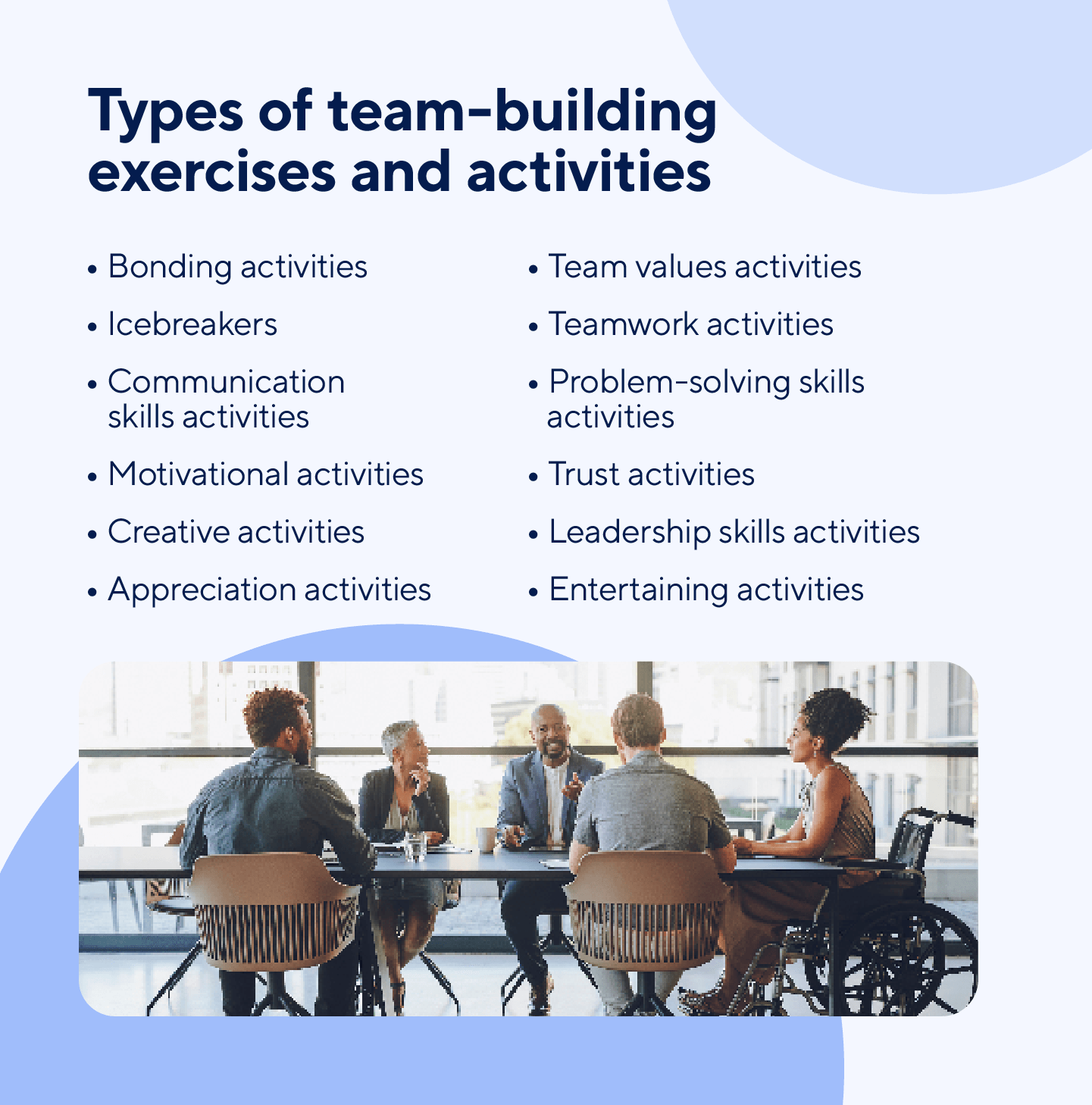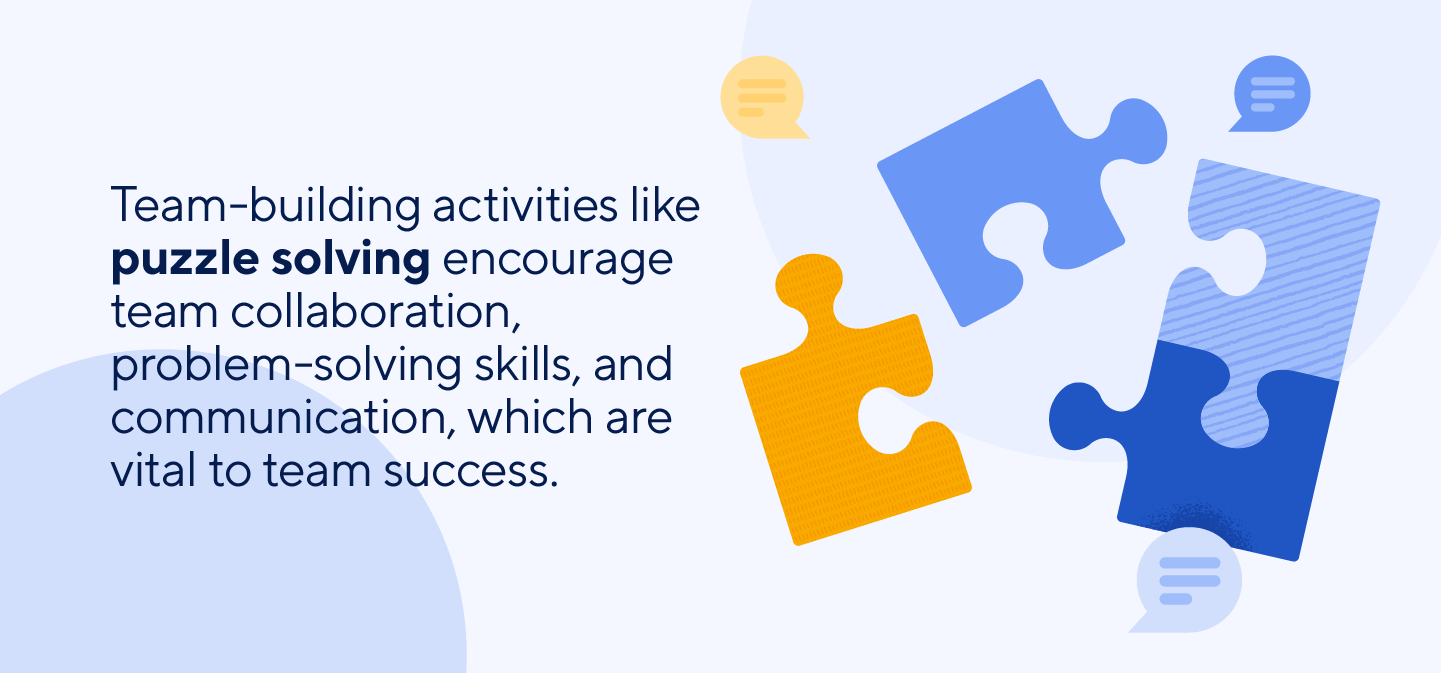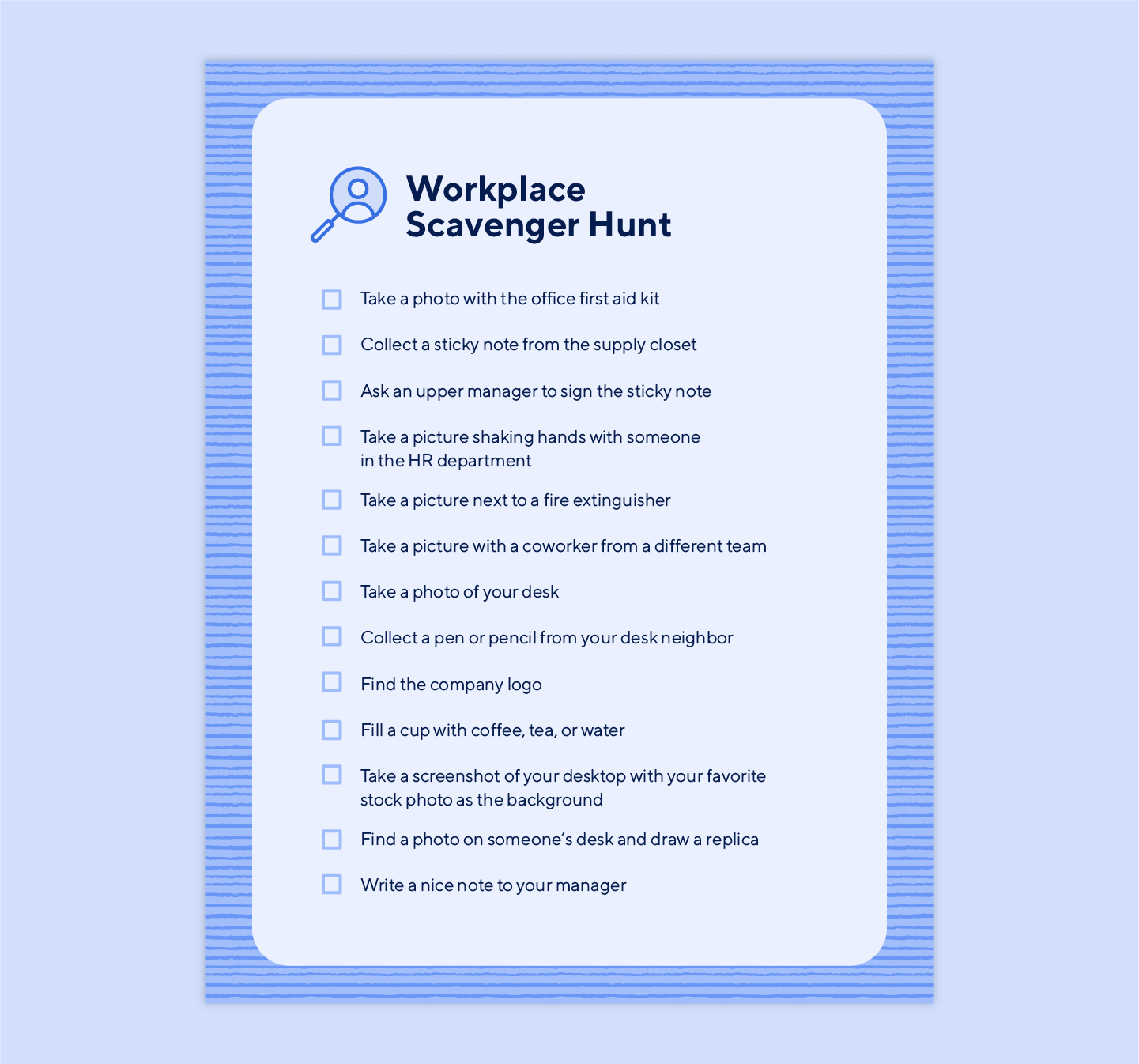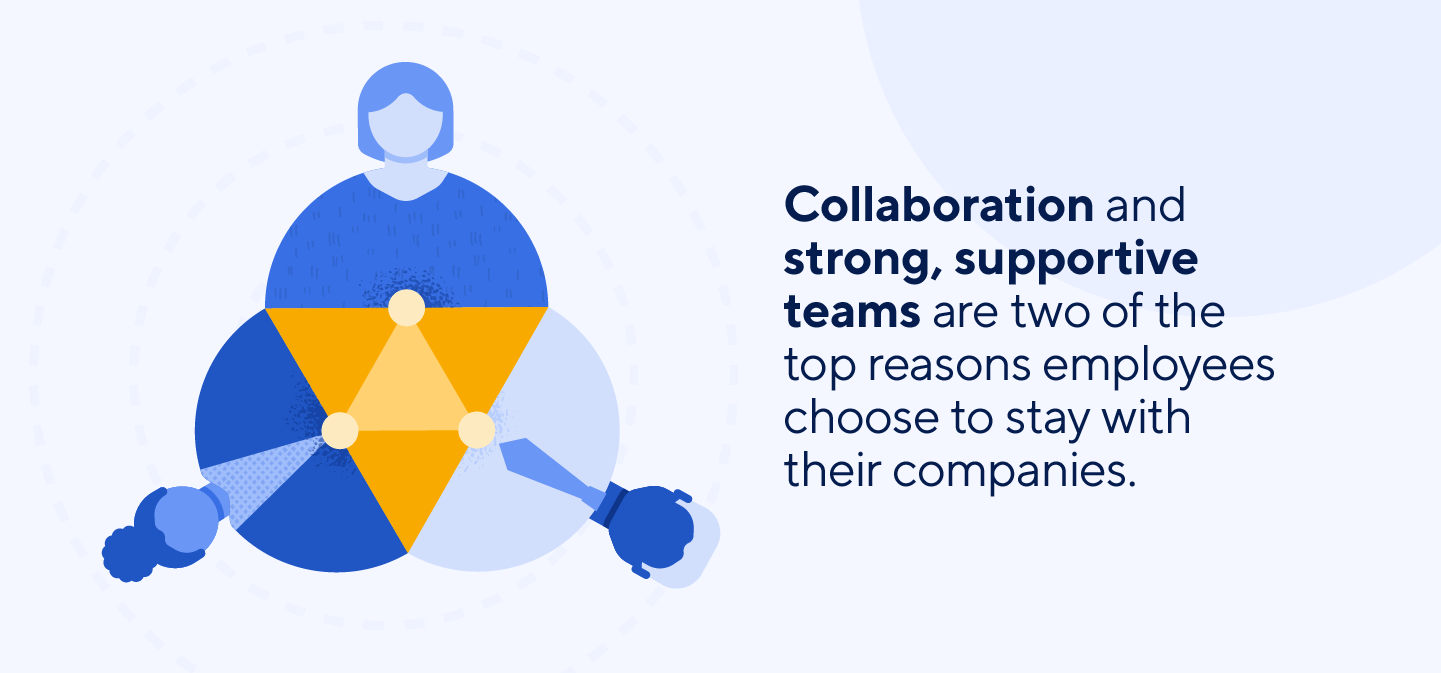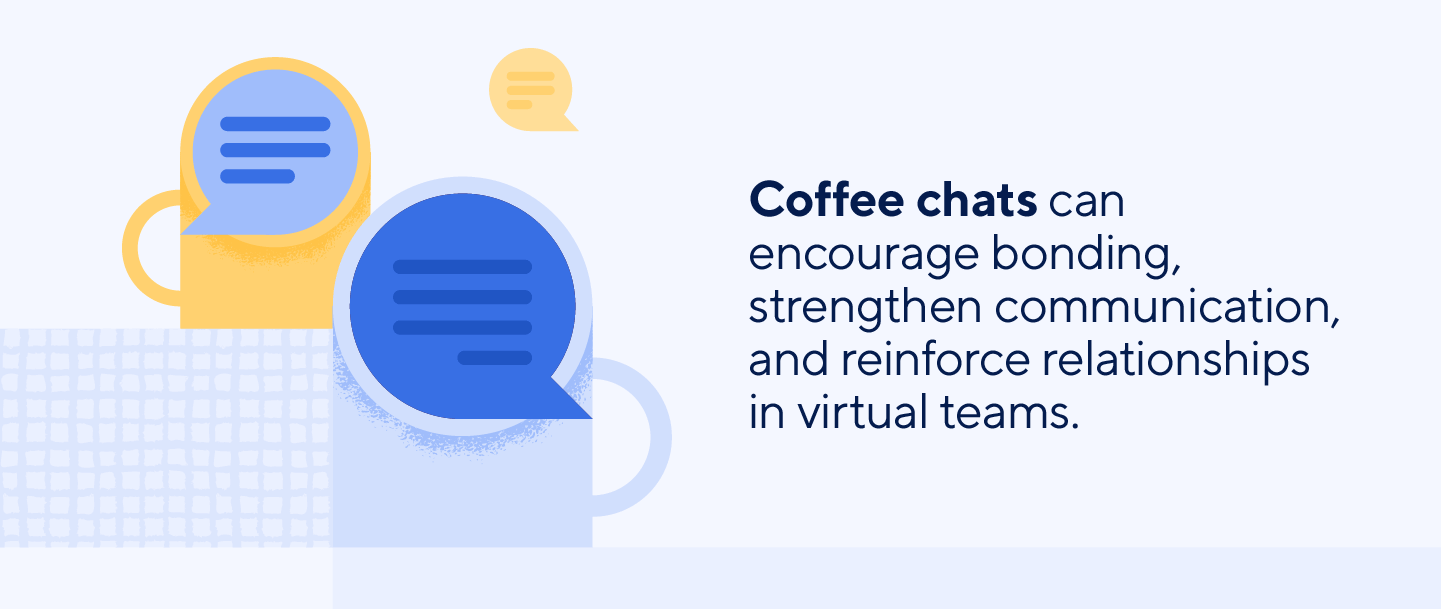Types of Team-Building Exercises and Activities
Better teams are built through collaboration and team exercises that break down biases, others require collective participation, and invest in team culture. While there are plenty of different team-building activities, many help promote teamwork and encourage workplace collaboration in the following categories:
- Icebreakers: Warm-up activities help participants get to know each other better and build camaraderie. Use icebreakers and other team-building games at the start of a longer team-building program to help bring people together who don’t typically work side by side.
- Bonding Activities: Bonding exercises encourage team members to feel connected to each other and their mission, follow directions, trust one another, and have confidence in their leadership.
- Communication Skills Activities: Communication is one of the most common weak spots for teams, and poor communication can give rise to misunderstandings, wasted work, and even internal sabotage. Communication activities often involve building trust, honesty, and clarity.
- Motivational Activities: Team-building activities can grow a worker’s appreciation for their coworkers, managers, and places of employment. Motivational exercises may even spur professional work forward.
- Creative Activities: Teams may require some encouragement to step outside their comfort zones or brainstorm creative solutions to a problem. These activities are designed to inspire action.
- Appreciation Activities: Employees who feel appreciated have much higher motivation and commitment to their work. Creating that feeling requires intentional effort, and sometimes managers need help feeling comfortable enough to extend praise. Activities that focus on these skills can build appreciation into your culture.
- Team Values Activities: These activities can help your team learn more about how they work together and what they value as individuals. When people have a better understanding of what their coworkers value, they have a point of reference for why they may behave a certain way. This knowledge can foster a more harmonious workplace.
- Teamwork Activities: Teamwork requires a range of skills, from learning to work with challenging personalities to forging a sense of common purpose. Teamwork activities help participants identify ways they can individually contribute to or hinder the success of an organization.
- Problem-Solving Skills Activities: Problem-solving activities focus on improving communication so that you can work together effectively to reach a common goal.
- Trust Activities: Teams work better together when they learn to trust the other members around them. These activities are designed to foster this value for all employees, including entry-level employees, managers, and company owners.
- Leadership Skills Activities: While many team-building activities have areas where leaders can naturally emerge, these exercises specifically targets improving help improve leadership skills.
- Entertaining Activities: Today’s business climate is demanding, but your team can’t work in the red zone all the time. You need to build in some fun so employees can recharge, maximize creativity, and feel passion for their work.
In-Person Team-Building Activities
If your team works together in an office environment or can meet up during working hours, these 24 in-person team-building activities are great for teams of various sizes.
1. Board Games
Number of Participants: 2 to 10
Objective: Team collaboration, problem solving, and communication
Time: 30 minutes to 1 hour
Materials: Board games of your team’s choice
Similar to puzzles, board games are a great way to encourage team collaboration. Games are great for networking, building relationships built on communication, and encouraging playfulness in a more structured environment. You can create a specific time for team members to play games, or you can leave them in the office to encourage continued collaboration throughout the regular workday.
2. Compliment Circle
Number of Participants: 2+
Objective: Appreciation and bonding
Time: 10 to 20 minutes
Materials: None
Teams work better together when they feel appreciated for both the work they do and the people they are. With a compliment circle, your team members have the opportunity to compliment their coworkers on their work, attitudes, project management, and more. You can do this in a group circle, via a communication platform, or anonymously.
3. Human Knot
Number of Participants: 6+
Objective: Communication and problem solving
Time: 5 to 20 minutes
Materials: None
The human knot is a popular camp activity that can easily be repurposed for a variety of teams. In this team-building exercise, an even number of participants stand in a circle facing forward. Members reach each of their hands forward and connect with two different team members, creating a web of interconnected hands. Participants then attempt to untangle the knot without releasing their hands, relying on team communication to solve the problem.
4. Spectrum Mapping
Number of Participants: 5 to 15
Objective: Communication and bonding
Time: 30 minutes to 1 hour
Materials: Whiteboard, sticky notes, and writing utensils
Teams consist of individuals with unique ideas, perspectives, and values. To align these — and encourage team communication about personal perspectives — spectrum mapping can be useful. In this activity, write a topic in the middle of a whiteboard, and have participants surround the topic with sticky notes filled with opinions and perspectives on the topic. Then, group these sticky notes into similar categories and facilitate conversations about the different ways the team views the topics.
5. Puzzle Solving
Number of Participants: 8 to 20
Objectives: Team collaboration, problem solving, and communication
Time: 30 minutes to 1 hour
Materials: Jigsaw puzzles
Team collaboration, problem-solving skills, and communication are vital to team success. In this team-building activity, participants work together to solve jigsaw puzzles. To challenge your team members further, split them into two teams that compete to solve their puzzles in a certain time frame. You can even mix puzzle pieces from different puzzles together, creating a scenario where both teams need to work together to succeed.
6. Order Formation
Number of Participants: 5+
Objective: Teamwork and problem solving
Time: 5 to 20 minutes
Materials: None
While verbal communication is important in an organization, nonverbal communication is just as necessary. In this team-building exercise, participants attempt to line themselves up in various orders — by height, age, name, birthday, or other factors — without speaking. Teams must grow their nonverbal communication skills to successfully complete this task.
7. Blind Drawing
Number of Participants: 2+ (even numbers work best)
Objective: Communication and teamwork
Time: 30 minutes
Materials: Simple printed or emailed images
Art isn’t easy for everyone, and it can be especially difficult if you’re trying to create something without a guiding image. In this exercise, pairs work together to create one cohesive image. Participant A attempts to draw the image assigned to them by their manager, but they can only draw using verbal instructions from Participant B. This team-building idea builds communication skills and patience.
8. Sneak-a-Peek
Number of Participants: 4 to 20
Objective: Teamwork and communication
Time: 30 minutes
Materials: Building blocks
In this team-building activity, participants are separated into two groups. A pre-made, replicable structure is hidden and a team member is selected to be the first direction provider. This person takes a sneak peak of the structure for 10 seconds, gives building directions for 30 seconds, and allows their teammates to build part of the structure for one minute. Repeat this so every team member can take a sneak peek and offer directions, and the first team to build the structure wins.
9. Two Truths and a Lie
Number of Participants: 2+
Objective: Communication, icebreaking, and bonding
Time: 20 minutes
Materials: None
To encourage participants to open up and bond with each other, set up a game of Two Truths and a Lie. Each participant will choose two truths about themselves and think up one lie, and then they will say all three to their team (without telling the team which is which). Team members then guess which statement is the lie. Remember that these statements don’t have to be extremely deep or personal in order for this team-building idea to be a success.
10. Count to 20
Number of Participants: 3+
Objective: Bonding
Time: 10 minutes
Materials: None
For this activity, your team will sit in a circle. The goal is to count to 20 as a group — without repeating numbers. Anyone can start the game at one and continue the count forward, but if two participants jump in at the same time, it’s game over. You can continue playing this game until you successfully reach 20 or you need to move on to a new activity.
12. Lunch and Learn
Number of Participants: 2+
Objective: Creativity, bonding, and entertainment
Time: 30 minutes to 1 hour
Materials: Depends on the topic
Do you have team members with cool skills — both personal and professional? If so, facilitate a lunch-and-learn session. These are short, educational talks during a team’s lunch break where participants can learn new skills. For example, you may have team members who want to lead talks about houseplants, design tools, watercolors, role playing games, or other unique skills.
13. Scavenger Hunt
Number of Participants: 2+
Objective: Bonding, icebreaking, and entertainment
Time: Any
Materials: Depends on activities
Download a Scavenger Hunt Template — Adobe PDF
Encourage your team members to leave their desks — and maybe the office — with a scavenger hunt. This can be a great hands-on approach for showing new hires around a company, introducing team members to managers and other departments, and educating participants about where supplies are, a company’s history, and more.
14. Tied Together
Number of Participants: 4 to 16
Objective: Teamwork, communication, and bonding
Time: 30 minutes
Materials: Long piece of rope or other tie
Similar to a three-legged race, this team-building activity is designed to test participants' teamwork and communication skills. Team members stand side by side and gather into a large circle where they are tied together at either the wrist or ankle. Once the whole team is connected as a single unit, they’re given small tasks to complete. To be successful, participants must be willing to assist others and accept help.
15. Collaborative Brainstorming
Number of Participants: 2+
Objective: Teamwork, leadership, and motivation
Time: 30 minutes
Materials: Notepad or note-taking application
While team building can be entertaining, it’s sometimes necessary to invest in team-building ideas that are business focused. Team brainstorms allow participants to communicate ideas, lead and facilitate discussions, and move projects forward in a collaborative manner.
16. Personality Tests
Number of Participants: 2+
Objective: Bonding, team values, and trust
Time: Any
Materials: Personality tests of choice and results
You may have heard of the Myers-Briggs Type Indicator, DISC assessment, Enneagram, or any number of other popular personality tests. Many professional teams are investing in these types of indicators because they help identify individual strengths and weaknesses, inspire communication and confidence, and offer insights into personal motivators — all of which can reinforce values and build trusting teams.
17. Hack Days
Number of Participants: 2+
Objective: Team values, creativity, and motivation
Time: 1 work day
Materials: Depends on the project
If you have a work day to spare, consider setting up a hack day for your team. This is a day specifically devoted to a project that benefits their team or company. These can be collaborative work days across all departments, or they can be smaller days set aside for a particular team. No matter the size of the hack day, the goal is simple: Elevate work processes or products in a single work day on a limited budget.
18. Code of Conduct
Number of Participants: 10 to 30
Objective: Team values and trust
Time: 30 minutes to 1 hour
Materials: Whiteboard, sticky notes, and writing utensils
This team-building idea is best suited for specific events, but it can be adapted for general use within a team. On a whiteboard, write the words “meaningful” and “pleasant.” Give your team members the opportunity to write ideas on how an event — or team — can be meaningful and pleasant, and stick them to the whiteboard. This mind map can then facilitate discussions on best practices, team values, and participant expectations.
19. Shark Tank
Number of Participants: 2 to 24
Objective: Creativity and teamwork
Time: 1 to 2 hours
Materials: Pitch presentations
This team-building idea is an ode to the television show. Assign participants to the roles of sharks or presenters, and then give presenters time to formulate a presentation for their proposal. These proposal ideas can be true team ideas they need help funding and organizing, or they can be mock ideas just for fun. Allow presenters to pitch their ideas and sharks to bid on ideas or offer tips on how to elevate a presentation.
20. Escape Room
Number of Participants: Up to 6 players per room
Objective: Problem solving, teamwork, and communication
Time: 1 hour
Materials: Escape room of your choice
Test your team’s problem-solving, teamwork, and communication skills with an escape room. You can create your own or take your team to a professional operation with a variety of escape room options. You can even increase this activity’s incentive by setting time goals or prizes for the fastest escape.
21. Trivia
Number of Participants: Any
Objective: Bonding, teamwork, trust, and entertainment
Time: 20 to 30 minutes
Materials: Trivia questions
Trivia is a team-oriented activity, designed for participants to work together and trust each other. Find a bar, restaurant, or other establishment that offers team trivia nights, and take your team on a team-building outing. If in-house trivia is more your style, you can create your own questions or use an online trivia game to entertain your team members.
22. Improvisation Class
Number of Participants: 2+
Objective: Icebreaking and communication
Time: 30 minutes to 1 hours
Materials: Improv class of your choice
Improvisation is more than just a theater term. Improv classes teach individuals how to communicate in unexpected situations, and they can be icebreakers for teams who feel uncomfortable around each other. These classes can push a team’s comfort zone to new heights, and it’s even possible to find both virtual and in-person classes.
23. Volunteer
Number of Participants: Any
Objective: Bonding and team values
Time: Any
Materials: Depends on volunteer service
Encourage your team to give back to their community by setting up a time to volunteer together. This type of team-building exercise helps align team values and allows team members to bond while helping others. Plus, you and your team can choose an organization to volunteer at together, which can further spur communication and teamwork.
24. Book Club
Number of Participants: 2+
Objective: Bonding, communication, and entertainment
Time: 30 minutes to 1 hour for meetings and additional time for reading
Materials: Club’s book pick or access to electronic books
Book clubs are great spaces for bonding, entertainment, and communication. Your team can pick any book — fiction or nonfiction, industry-specific or not — and set aside some time to read and discuss it. If you choose an industry-specific book, you can assign team members to present their findings, questions, or confusions to the group, and if you choose an entertaining read, you can simply gather together to discuss the plot, characters, or themes.
Virtual Team-Building Ideas
Even if your team is unable to meet in person, it’s important to foster an open and collaborative remote company culture. By incorporating virtual games and experiences into your team’s activities, you can build strong, collaborative teams across time zones.
25. Online Games
Number of Participants: 2+
Objective: Bonding and communication
Time: Any
Materials: Online game options
While you may not be able to sit around a physical table and move game pieces around a tangible board with a remote team, you can still play a variety of online games — including board games that have been adapted for the screen. Online games can help build team camaraderie and communication in a fun, safe environment.
26. Bingo
Number of Participants: 2+
Objective: Entertainment and bonding
Time: 10 to 30 minutes
Materials: Bingo cards and bingo number generator
Four corners, blackout, regular old bingo — you name it! This classic game is easy to understand and play, plus your team members can bond over a simple game of luck. You can even create your own bingo sheets themed around your participants’ favorite sports teams, an important project they’re currently involved in, and more.
28. MTV Cribs
Number of Participants: 2+
Objective: Bonding and entertainment
Time: 5 minutes
Materials: Camera
Just because your team works in different places doesn’t mean they aren’t hospitable. In honor of the classic ‘90s show, encourage your team members to film short videos of their offices — or homes, if they’re comfortable — to give their coworkers a look into their personalities and everyday lives. These can be as simple as a tour of a participant’s desk accessories or as detailed as a full home walk-through.
29. Storytelling Workshops
Number of Participants: Any
Objective: Team values, creativity, and motivation
Time: 1+ hours
Materials: Workshop of your choice
Encourage your team’s creativity with storytelling workshops. These workshops can be short, single visits from industry experts, or they can be longer, more involved processes. Storytelling can encourage team members to think of creative, out-of-the-box solutions to team problems, and an expert-led workshop is a great place to start.
30. Remote Debates
Number of Participants: 6+
Objective: Communication, teamwork, and problem solving
Time: 30 minutes
Materials: None
Disagreements and differing opinions are bound to occur within any team. Remote office debates can help teams learn how to handle these differences and prepare participants for future public speaking engagements. Before engaging in debates about hot topics, designate a moderator — or take on the role yourself — to ensure each side of the dispute is heard and treated with respect.
31. Coffee Chats
Number of Participants: 2+
Objective: Bonding, communication, and entertainment
Time: 30 minutes to 1 hour
Materials: Drink of choice
Virtual team members may never meet face-to-face, but they can still get together in a stress- and expectation-free environment. Coffee chats are designed for team members to grab a cup of their favorite beverage — coffee or not — hop on a video call, and socialize. These meet and greets can be scheduled across time zones, grouped by city, region, and interests, or open to everyone in a virtual team.
32. Virtual Happy Hour
Number of Participants: Any
Objective: Bonding and entertainment
Time: 1 hour
Materials: Drink of choice
Virtual happy hours are similar to coffee chats. These get-togethers are perfect for after working hours, and they can be a place for open chats about different topics. Incorporate trivia questions or other fun activities into your virtual happy hours to encourage team members to relax, bond, and have fun.
33. Craft Challenge
Number of Participants: 2+
Objective: Creativity
Time: 30 minutes
Materials: Depends on the craft
For this activity, you need the element of surprise. Send your team a message or an email at a random time and challenge them to a craft-off. This team-building activity requires participants to use whatever materials they already have to create a one-of-a-kind craft. You can even have participants submit photos of their masterpieces for a team vote where the favorite creation earns a prize.
34. Remote Coworking
Number of Participants: 2+
Objective: Bonding, communication, and teamwork
Time: Any
Materials: None
Your team doesn’t have to live in the same place to be able to work together. Instead, encourage team members to engage in live remote coworking. This can spur productivity, strengthen professional and personal relationships, and inspire different types of remote collaboration.
Why Are Team-Building Activities Important?
Team-building activities are incredibly important for every team because they help identify team challenges while simultaneously encouraging individual strengths and relationships. No matter where a team is located, whether it’s in person or remote, or how many members a team consists of, team-building activities also do following:
- Encourage company networking and team socializing
- Boost team performance
- Motivate celebrations and team spirit
- Inspire innovative solutions to team challenges
- Enhance company culture
- Align individual, team, and company goals and values
- Revitalize fun in the workplace
- Show employee appreciation
- Build cross-departmental connections
- Enhance employee engagement and morale
- Stimulate team-building questions that can boost team cohesiveness
Researchers have even recently found that virtual team building can improve team communication and morale by more than 60 percent. So, the results are in: Team-building activities are vital to the success of professional teams — and their companies.
Foster Effective Team-Building With Real-Time Work Management in Smartsheet
Empower your people to go above and beyond with a flexible platform designed to match the needs of your team — and adapt as those needs change.
The Smartsheet platform makes it easy to plan, capture, manage, and report on work from anywhere, helping your team be more effective and get more done. Report on key metrics and get real-time visibility into work as it happens with roll-up reports, dashboards, and automated workflows built to keep your team connected and informed.
When teams have clarity into the work getting done, there’s no telling how much more they can accomplish in the same amount of time. Try Smartsheet for free, today.
